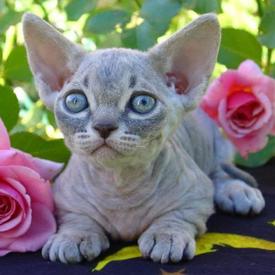
A relatively new breed, the Minskin is just over a decade old. Developed by Paul McSorley in 1998 from Boston, Massachusetts, the Minskin is the result of selective crossing between the Sphynx and the Munchkin. McSorley desired a cat with fur that was restricted to the points just as the Sphynx has colour at the points, but with short legs as opposed to the Sphynx’s long, slender legs. To achieve this, McSorley acquired two cats and began a careful breeding program to establish a new breed that met his requirements. The Minskin was developed in 2000 and five years later, some 50 cats were in existence. It is not yet recognised as a distinct breed by the International Cat Association.
Like both its forebears, the Minskin is a unique, memorable breed in terms of its personality and appearance. Low to the ground due to its short legs, the Minskin boasts a small to medium-sized body, with large ears, a tapering nose, a very sparse coat, and wide, round eyes. The velvety-soft fur of the coat is seen at the points or extremities, including the face, ears, tail and legs. All colours and patterns are permissible, although the most commonly observed colours include tortoiseshell, tabby and solid colours. The short coat requires little in the way of grooming and barely sheds, making this a great breed choice for the house-proud!
Although the breed is rare, owners, breeders and enthusiasts alike have described the Minskin as a highly active, playful and animated breed that will liven up any household. Besides this, the Minskin is very affectionate, sociable and loyal, forming strong attachments to its human family. Because of its natural love of people, the Minskin demands attention and companionship and doesn't like being left alone for long periods of time. Generally speaking, a healthy Minskin will weigh 4-6 pounds, with a typical life expectancy of 12-15 years.
Due to the rarity of the Minskin, determining any breed-specific or genetic health conditions is difficult. It is thought that this breed is healthy, resilient and long-lived.
Do you own a Minskin? Let others know what they're like!
Related products
Advantage 80 Spot On Flea Control Large Cats and Rabbits
from £12.95
Advantage 40 Spot On Flea Control Cats, Small Dogs and Rabbits
from £12.95
Advantage 250 Spot On Flea Control Large Dog
from £12.95
Advantage 100 Spot On Flea Control Medium Dog
from £12.95
Drontal Tasty Bone Wormer Tablets for Small & Medium Dogs (2 to 20kg)
from £2.15
TermaWorm™ Tablets for Cats & Dogs
from £1.79
Drontal Tasty Bone XL Wormer Tablets for Large Dogs (Over 20kg)
from £6.39
Advantage 400 Spot On Flea Control Extra Large Dog
from £12.95